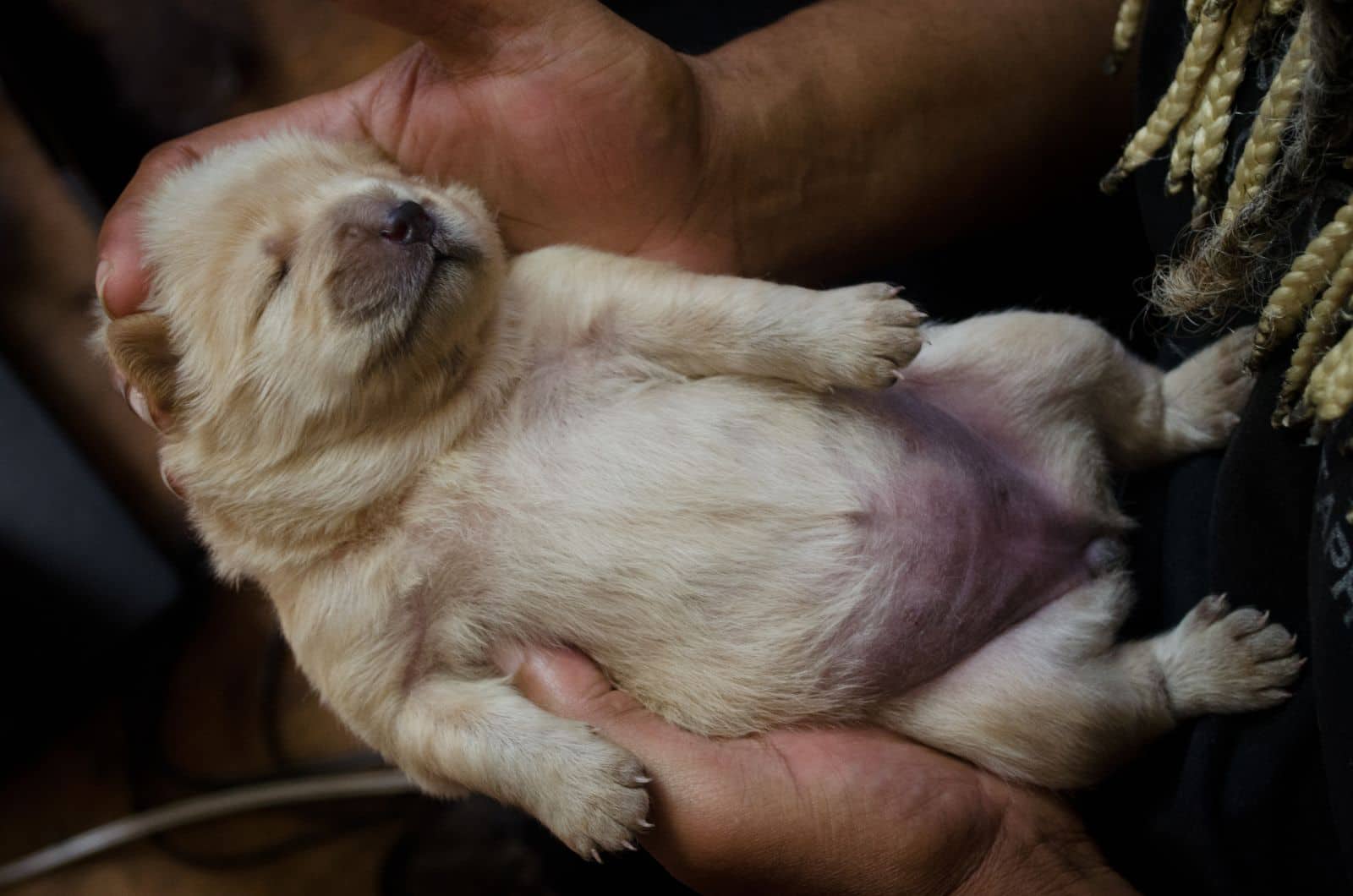A puppy is just about the cutest thing you’re going to lay your eyes on, but they’re not without their health issues. One of many relates to their tummy and the many problems relating to it, but what does a normal puppy belly look like?
The answer to the question of “what does a normal puppy belly look like” is simple to a degree. They’re relatively smooth, and nice and soft.
Your puppy’s stomach shouldn’t be hard or tight at all and should feel somewhat elastic and squishy.
After eating, it’s normal for the tummy to feel a little bloated or distended, like a semi blown up balloon, but nothing too big.
Anything else is usually a good indicator of some underlying health issues that he may have.
These usually tie back to some allergies, a yet undeveloped digestive system or some other anomalies that may lead to a swollen belly or worse issues.
The array of problems also depends on what dog breed your little pupper belongs to as there are some hereditary diseases specifically tied to the genes of a breed.
Sometimes, these issues are merely related to something harmless like gas or overeating, leading to a swollen belly.
Other times, however, they can be more serious, or even life threatening if it’s something like worms or bloat or if it’s anything that may cause violent vomiting or diarrhea.
To find out what a normal puppy belly should look like as well as the many causes which can alter that and the questions people often ask regarding this topic in particular, be sure to read on.
So, What Does A Normal Puppy Belly Look Like?
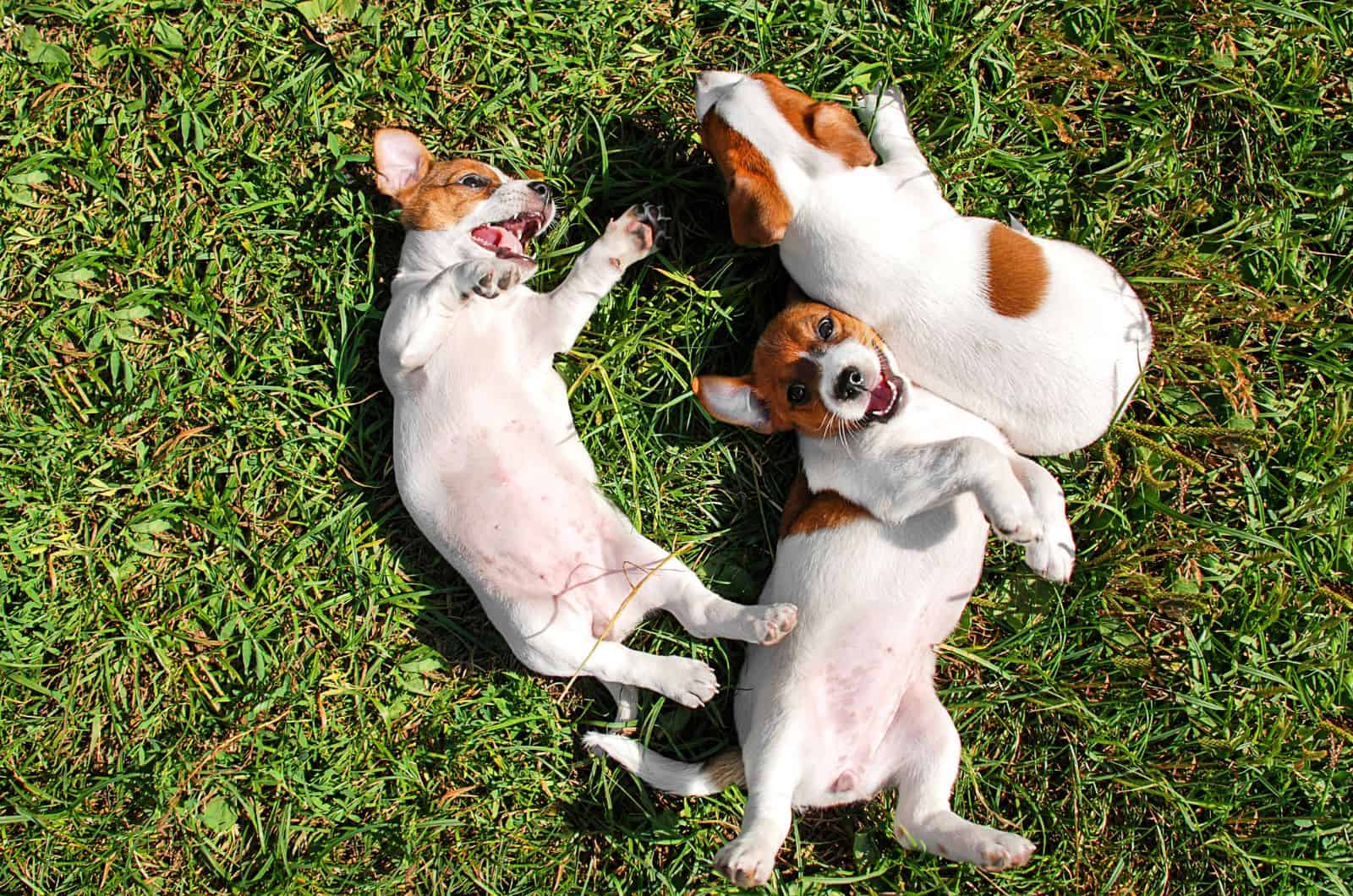
Before we go into detail about the many different types of issues that deform the puppy’s stomach, it’s good to establish the idea of the puppy’s ideal form first.
Once again, we want it looking relatively soft and smooth with a texture of a soft ball of dough that we can press into a little, but not too much.
It should be like a tiny ball of jello to a degree, one that you can move about a little and have the weight of it shift the puppy around.
As he grows, his belly will too, often changing shape and even distending a little bit here and there, but that’s all par for the course as both he and his digestive tract develop over time.
What Things Should I Be On The Lookout For When Searching For Abnormalities?

While all dogs are different, the best way to figure out if something is off is if it looks different than it always does.
A little obvious, sure, but that’s the simplest way of going about it.
The signs you’re looking for are ones you’d expect to happen to you as well, at least some of them are.
1. Stomach Inflation
If his stomach inflates and bloats up, feeling rigid rather than soft and squishy, he may be suffering from bloat, otherwise known as GDV (Gastric Dilatation and Volvulus), a pretty dangerous condition if left unchecked.
However, a stiff stomach doesn’t always relate to these life threatening problems, it could be something a little less harmful, but still dangerous if untreated.
Things that have a few more obvious signs to them like vomiting or diarrhea.
The exact cause could be a multitude of things, from food poisoning and allergies to various illnesses and diseases.
Not every form of swollen belly is a cause for concern.
There’s the slight swelling that happens after a meal, but it still looks squishy and relatively normal, and then there’s the swelling which looks like you’re making a puppy balloon.
2. The Puppy Seems Like He’s Out Of Energy
Another common follow-up symptom to the problem is lethargy.
If your dear doggo seems to have less oomph in him than he normally does while also having a bloated stomach, it may be that he has contracted worms or some other intestinal parasites.
The most common ones would be tapeworms, roundworms or hookworms, often ingested from random stuff they decide to swallow or contaminated food.
Thankfully, they’re easy to get rid of, albeit unpleasant to deal with on the puppy’s side, what with the general discomfort, what with the constant loss of fluids through diarrhea and vomiting, what with the general lack of energy that’s simply awful to experience.
The worst part for them may be the loss of appetite, which is likely the most apparent sign that something is wrong, considering how ravenous puppies can be when it comes to food.
3. Your Puppy Has A Hernia
Yet another thing that’s relatively easy to spot is if your dog has a hernia.
While rare in young pups and more common as time goes on, a hernia can be a problematic experience if left untreated.
A hernia is a condition where one’s abdominal organs burst through the abdominal wall. Burst may be a strong word, but part of them protrudes out essentially which materializes itself as this large and odd growth on the side.
It’ll only get worse over time if action isn’t taken, and it won’t get better without proper treatment, or surgery in most cases.
Thankfully, it’s a routine operation and shouldn’t cause any further complications once it’s finished.
4. He Has Enlarged Organs
The final cause of a bloated stomach can be caused by enlarged organs.
These certainly aren’t a common occurrence and happen during rare and problematic periods in a dog’s life, ones that you may not expect to happen to a dog in such an early stage in his life, but they’re certainly possible.
The 3 main causes here are:
- Injuries to the abdomen
- A tumor
- An inflammation of the bowels
If this is what’s causing your puppy’s belly to become enlarged and distended, take him to the vet for a check-up and further instructions on how to treat the issue.
What Are Things That Can Cause A Big Belly In A Puppy?

The things mentioned prior were only visual tells that something is wrong, however, we’ve only briefly gone over some of the potential causes there.
There are plenty of things that can go wrong, especially when a stomach is in question. Some can happen to every dog while a few of them are more likely to happen with certain dog breeds.
Here are some of the more common ones:
1. He’s Just Fat
As your puppy grows, he’s likely to put on some weight, and, as I’ve mentioned before, pups are known to be notoriously hungry, much like any child.
When they’re still feeding on their mom’s milk, they may get slightly rotund from overeating and the dog’s belly may go through a bit of an enlargement.
Thankfully, this is a temporary thing and everything should go back to normal once your pup digests the food that he’s eaten.
That said, once he grows older, you may need to throw him on a diet while making sure he gets his exercise in. Sure, pups need to put on weight at an early age, but too much and then he’ll have to deal with obesity issues which opens up a whole new can of worms.
2. He Has A Hernia
While I’ve already mentioned hernias earlier, it’s worth knowing exactly what it is.
An abdominal hernia specifically is when your pet’s intestines push through the abdominal wall and enter the subcutaneous layer, also known as the fatty layer.
It manifests itself much like it would in humans, an odd growth on the point of the abdomen where the ‘leak’ happened.
It’s definitely not pretty to look at, but it is curable, whether through treatments or surgery, depending on its current state and when you’ve decided to act on it.
While it can happen to almost any dog, it’s more common in Dachshunds, Poodles and Yorkies.
If you own one of these dog breeds, or intend to, keep an eye out for these odd growths. It may just be a hernia.
The symptoms of a hernia aren’t just visual either, they’re plentiful, albeit easily confused with something else, thankfully, the primary one is easily discernible.
Other symptoms may include:
- Lack of energy
- Vomiting
- Less or no urination at all
- Sluggish movement
- Abdominal pain
- Difficulty breathing
3. He’s Eating Too Fast
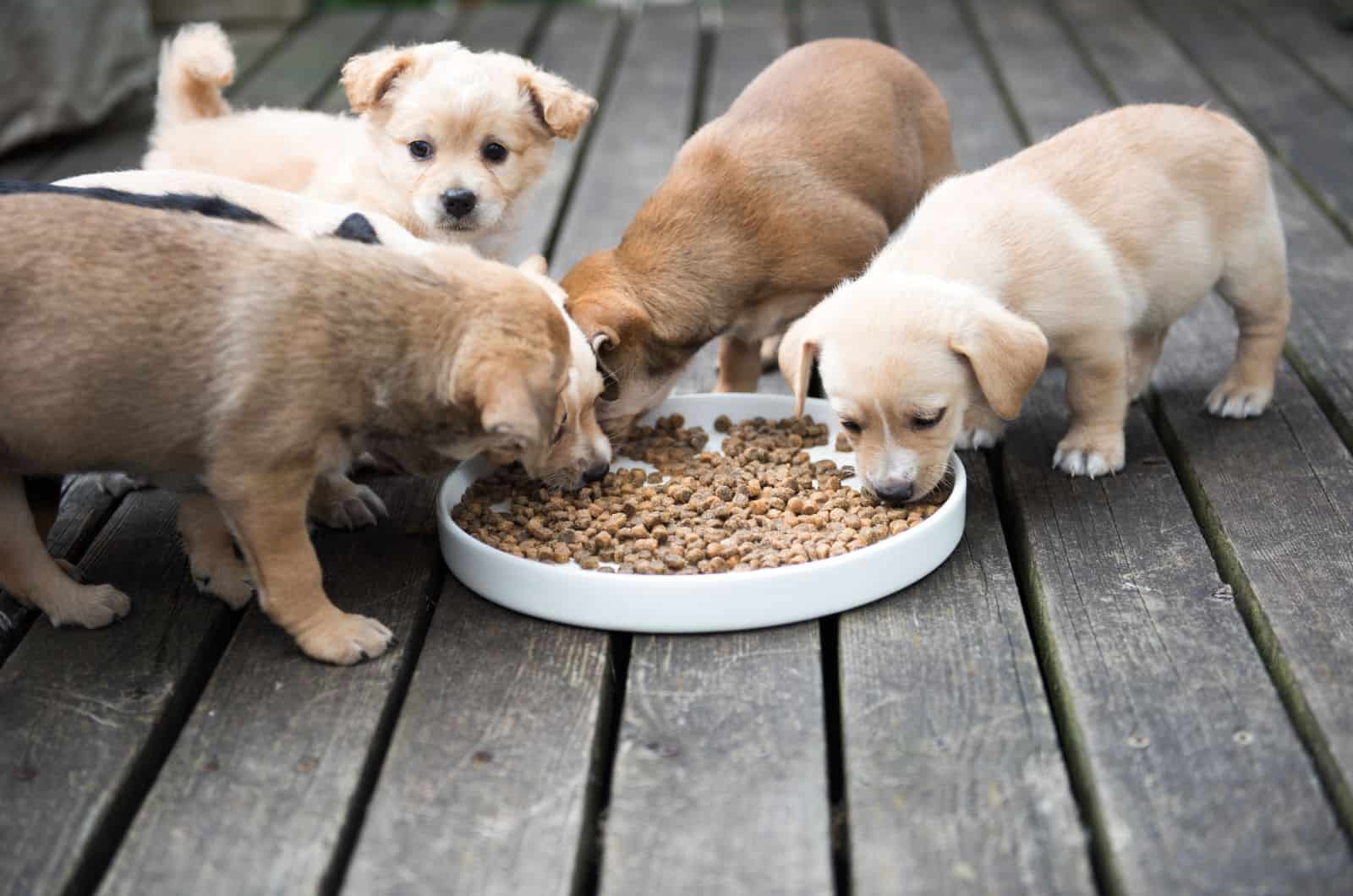
Another common feel and appearance of a bloated belly is if your pupper doesn’t chew his food when he moves on to solids, or if he just goes through any sort of food way too quickly.
His stomach won’t be able to catch up and will just grow larger as it gets backed up to let things get processed properly and the nutrients absorbed.
You’ll have your little tubby furball for a bit, but it should be done by the end of the day.
If this happens, however, make sure he takes it slow as he’s likely to get sick from eating like this, and he may end up becoming cause #1 which is being too fat, and that’s something you’ll want to avoid in every dog.
Teach him to eat slower or relegate the feeding pace to yourself so he can learn what’s adequate and what isn’t by portioning his food.
Most dogs often don’t know when to stop and will eat until they barf it all back out, and then some if they don’t learn. Believe me, I’ve had one who could not hold himself back and would eat whatever was given to him.
4. A Buildup Of Fluid (Ascites)
While this too is a condition more commonly affecting older dogs, fluid build up or Ascites, can occur even in pups, especially if they’re born with a pre-existing heart condition.
It can also happen if they suffer from PDA (Patent Ductus Arteriosus) which is represented as an unusual connection among two major arteries which can create a whole mess of trouble with an abnormal blood flow.
The excess fluid that the heart would normally pump out gets backed up in other areas due to its reduced effectiveness. The most commonly affected areas end up being the chest and the abdominal area respectively.
However, there are a few rarer causes to fluid build up in the body, commonly related to various cancers, issues with your dog’s liver or if his bladder ruptures for whatever reason.
This is a pretty serious issue too, and if you see something wrong with your dog, you should act immediately and get him over to a vet as soon as you can so no further complications develop.
The best way to resolve it is through surgery or dietary changes among others which can be tough for the pupper to get used to, but is a necessary change overall.
What Are The Symptoms Of Fluid Build Up?
It’s not that easy to discern the symptoms of this issue with those of other ones given how similar they are, but any sign of them should be cause for alarm regardless and should make you get him over to a DVM anyway
Here are some of the more common symptoms:
- Heavier breathing or wheezing
- Easier fatigue
- Slower movement
- Inflated stomach
- Accelerated heart rate
- Overall feeling of weakness
5. A Parasitic Infection
Next up is another all too common issue with pups, worms and other intestinal parasites.
These bastards can cause a whole heap of trouble for your little buddy and are not fun in any way.
As mentioned earlier, ringworms, hookworms, roundworms and tapeworms are some of the most common ones, but there are various other types.
Regardless of which one has infected your pup, they’re all going to cause him similar issues like:
- Drastic loss of weight
- Lack of energy
- Sluggish movements
- Diarrhea
- Vomiting
- Enlarged and bloated stomach
- Eating little to no food
- Loss of coat color
Once again, symptoms similar to many of the other issues found here, but that just further reinforces the need to get him or his stool sample to a vet as quickly as you can.
Once again, parasites are easily solved through medication and deworming procedures.
For pups, even if they don’t appear to have any of the symptoms showing yet, it’s good to take them to a deworming every other month just to be sure.
6. Bloat

Also known as gastric dilatation and volvulus or GDV for short, bloat is a plague on large and giant breeds due to their overall size and age later down the line as their center of mass is positioned awkwardly, making their body more prone to this issue.
The issue in and of itself is caused when the stomach literally twists around itself and fills up with gas, food or liquid while also cutting off blood flow to the organ.
It’s a life threatening condition that gets worse over time and if left untreated.
Getting your dog over to the vet is imperative the moment you spot some of the clear signs of it.
Some of the more common and apparent ones are:
- Abdominal distention and stiffness
- Constant pain in the abdominal area
- Anxious behavior
- Dry heaving
However, while it may be more common in older, large breed dogs like the Saint Bernard, the German Shepherd or the Great Dane, it can also happen to dogs of any age and size.
It’s commonly caused when your puppy stuffs himself with food or liquids, or if his body undergoes heavy physical stress too soon after a meal like exercising.
Treatment options most commonly revolve around taking IVs in to keep the body fed and frequent walks to help untangle the puppy’s tummy so he can get back to normal.
See Also: Will A Dog With Bloat Drink Water? Useful Tips
7. Various Infections And Inflammations
To nobody’s surprise, infections have made it to this list as have inflammations of internal organs.
Conditions such as pancreatitis, liver disease or kidney problems can lead to this potbelly appearance with a bloated stomach and various difficulties.
Difficulties like lethargy or severe abdominal pain accompanied by the symptoms of the corresponding inflammation.
Infections themselves are some of the worst offenders though with Peritonitis being one of the more dangerous ones to look out for given how high the canine mortality tied to that infection is.
Peritonitis occurs when the dog’s peritoneal cavity gets inflamed, usually due to a rupture or similar, but the likelihood of its occurrence is also boosted by several of the other bloated belly causes mentioned above like bloat or pancreatitis.
Given how it inflames the inner lining of the abdomen, it’s pretty serious and can cause a whole load of trouble for your canine companion with symptoms like:
- Fever
- Shock
- Low blood pressure
- Internal bleeding
- Blood poisoning
- Severe abdominal pain
- Swelling of the stomach
- Fluid build up
And even more.
The high mortality comes from the sudden influx of toxins that flood the body and cause it to almost shut down.
Thankfully, the problem is treatable, but is best when it’s discovered early.
The vets will perform various tests through blood samples, x-rays and the like to determine whether or not peritonitis is a potential threat for your dog.
The immediate course of action falls down to a surgical procedure where the foreign contents have to be drained out and the abdomen closed up and cleansed, followed by a lengthy recovery period.
It’s definitely no joke, and is best that you do frequent check-ups with your pup if you suspect anything might be amiss.
8. Allergies
Allergies, while not the most common offender to the look of a normal belly, can cause some level of bloating and stomach inflation in general, but it depends from dog to dog.
After all, every pooch has different allergic reactions and some may manifest as a sneezing fit or a temporary bout of diarrhea, but some may experience severe bloating.
While usually not life threatening, it can be irritating to the canine.
I recommend quickly figuring out which ingredient of the food that you put in your pup’s food bowl causes this issue and eliminating it from his diet so he can live a healthier life.
After all, you never know if that allergy may end up manifesting a more severe reaction later down the line if not kept in check.
9. Cushing’s Disease

Finally, we have Cushing’s disease, also known as hyperadrenocorticism, a condition that occurs due to a larger production of cortisol by the adrenal gland which affects your dog’s overall appearance and health.
Cortisol is the stress hormone, often responsible for our fight or flight responses and allowing us to perform better under pressure.
It sounds good on the surface, but too much of a good thing always turns bad, and such is the case with this one too.
After all, it is the stress hormone and will put your dog’s body under a lot of stress which will have negative effects on it in the long term.
Some of the more common ones for pups are:
- Excessive weight gain
- Increased need for food and water
- Frequent urination
- Loss of hair
- A larger belly
- Lack of energy
- Getting fatigued easier
- Skin inflammation and overall lower skin quality
Though more prevalent in smaller breeds like the Poodle, Boxer, various Terriers or Dachshunds, it can still happen to any other dog, regardless of size and age, much like any of the other ones mentioned here.
Sadly though, the disease is a lifelong companion and a pretty serious condition, for better or worse, but can be treated through medication.
The reason being that surgical options are often too risky to attempt and are often left as such since, if the cause of the disease is due to a tumor on the adrenal gland, it’s often too hard to remove.
Thankfully, your pup can live a relatively decent life even with the disease, though he will require constant monitoring by the DVM and yourself for any signs of problems.
This is especially true when you realize that the only meds available often have incredibly severe side effects themselves.
How To Prevent Stomach Bloat In Pups?
We’ve answered the question of “what does a normal puppy belly look like” as well as answered what causes abnormalities with the stomach itself, but we haven’t yet answered how to prevent bloating.
We have with certain cases, but not with everything. Here are a few general tips to prevent many of these issues from causing your puppy’s stomach from swelling up or distending, most of which are tied to proper food intake.
1. Portion His Meals
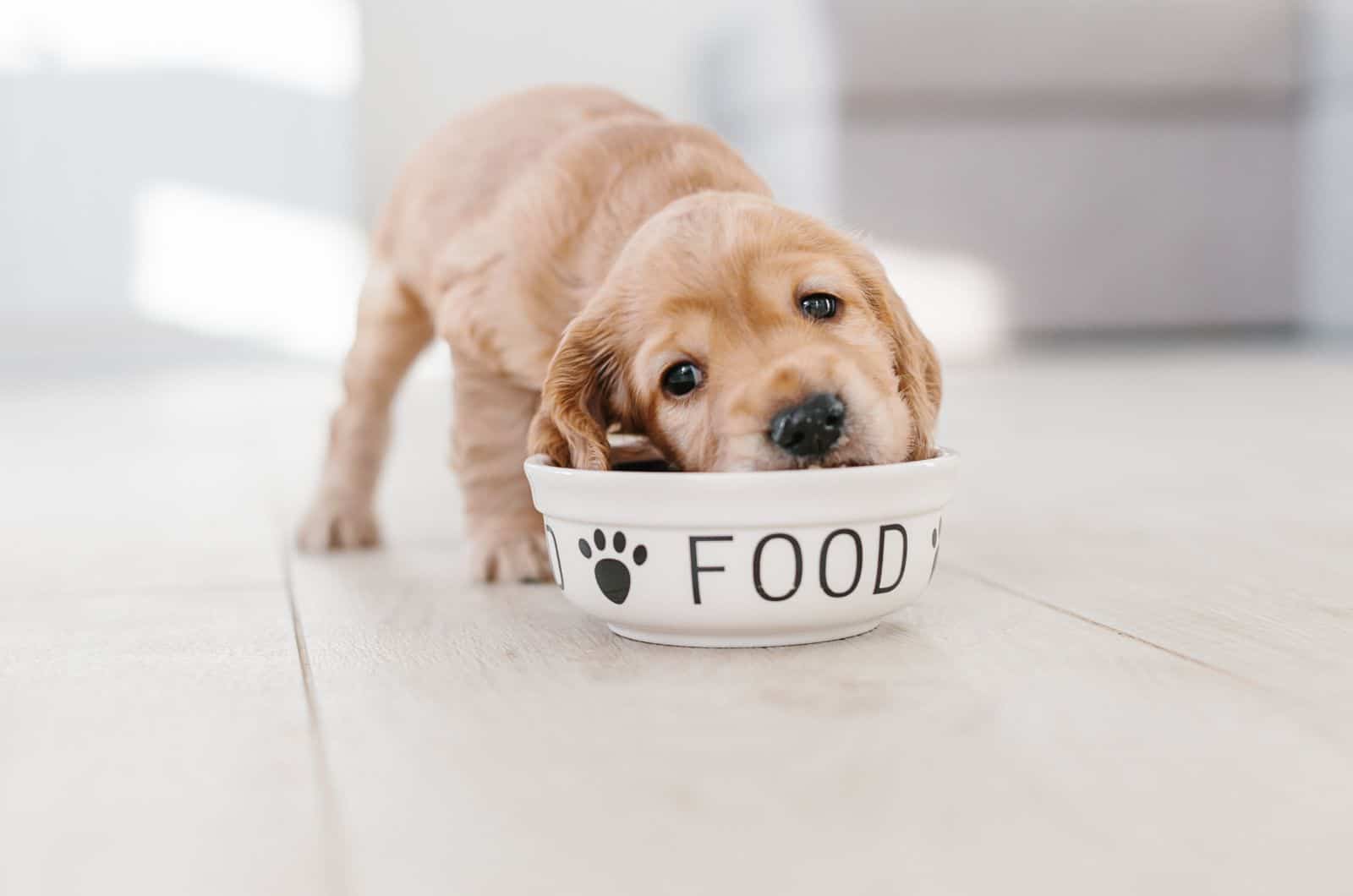
Avoiding fewer large meals throughout the day and sticking to more small meals instead keeps his digestive system always working, but not getting overworked, even if the pupper eats faster than he should.
It’ll help keep him fit too and put less strain on the dog’s stomach which will help prevent many of the aforementioned causes of bloated bellies.
2. Smaller Amounts Of Available Water
Similar to the earlier option, you should portion his water too. Sure, your dog needs to stay hydrated just as well as you, but they often get too greedy and will drink their own weight in fluids.
If your puppy acts this way, portion his water just as well as you do his meals to keep his stomach from inflating.
3. Teach Him To Pace His Eating And Drinking
The best way to prevent most of these issues is to get your puppy through some simple behavior correction with a little bit of training.
Teaching him that his food won’t go anywhere and that he should pace himself, chew his food properly before swallowing as well as only take the amount of water that he needs to quench his thirst are the cornerstones of a healthy-looking stomach.
It’s by no means easy, but if you persevere, the results are going to be well worth it.
4. Change His Diet Up
If the cause of a larger belly is eating fatty foods or generally a lot of unhealthy stuff, then you may want to change his feeding regimen to something healthier.
It’ll help prevent potential inflammation and problems with his kidneys and other organs later on in life.
5. No Exercise After Eating
The main cause of bloat is the honest mistake people make by thinking exercise can be practiced at any time, which, in terms of dogs, isn’t the right way to go about it.
Allow your dog some time to breathe and have the food settle before you get him to exercise. An hour should usually be enough.
In Conclusion
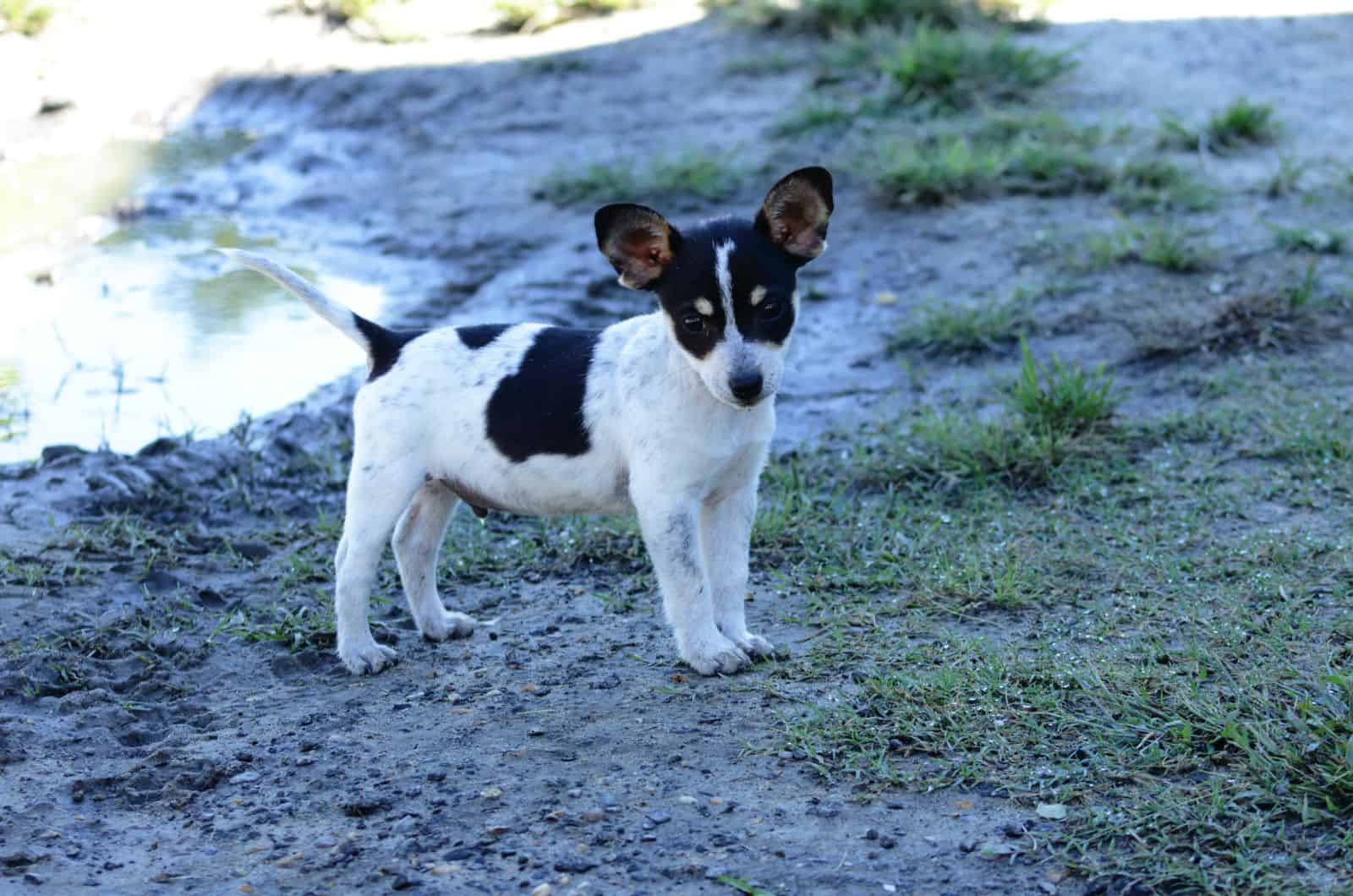
What does a normal puppy belly look like?
As we’ve seen, that depends from breed to breed, but most of them generally look smooth and squishy with a decent bit of wobble.
Some distention is bound to happen as he grows, but anything other than that, especially if followed by other concerning symptoms, should be checked out by a vet in case it’s one of the many threatening causes for bloated bellies.
Dog owners should be attentive to their pups when it comes to this so they can spot any abnormalities early to make it easier to resolve the issue without any complications.
I trust that you have only the best interests for your canine companion and I hope I’ve helped you learn something new today. Until next time.
RELATED LINKS:
